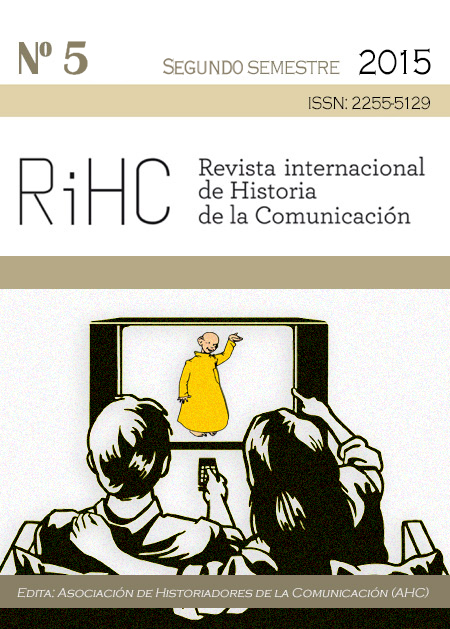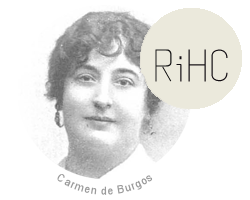Amarillismo e infoentretenimiento en la información televisiva sobre la crisis económica: el caso de Cuatro TV (2012)
DOI:
https://doi.org/10.12795/RiHC.2015.i05.05Keywords:
Televisión, crisis económica, sensacionalismo, infoentretenimiento, interés humano, personalizaciónAbstract
Este artículo mide el impacto del infoentretenimiento y el amarillismo televisivo en las noticias sobre la crisis económica emitidas por Cuatro TV entre abril y junio de 2012. Para ello aplica un análisis de contenido a una selección aleatoria de noticias (n=159) en el que se consideran las siguientes variables: piezas emitidas sobre la crisis, duración de las mismas, posición que ocupan en la escaleta de emisión, encuadre aplicado en las mismas y tipo de fuentes que aparecen en las informaciones. Se concluye que el principal rasgo sensacionalista presente en estas noticias es la preferencia por fuentes de tipo personal e individual, mientras que la adopción del enfoque del interés humano es secundario.
Downloads
References
ABEL, A. D., & BARTHEL, M. (2013). “Appropriation of Mainstream News: How Saturday Night Live Changed the Political Discussion”. Critical Studies in Media Communication, 30 (1), 1-16.
ARRESE, Á., & VARA-MIGUEL, A. (2014). “Alarma y alarmismo: medios de comunicación y crisis económica”. Estudios sobre el Mensaje Periodístico,20 (2), 933-851.
BELL, C. V., & ENTMAN, R. M. (2011). “The media's role in America's exceptional politics of inequality”. The International Journal of Press/Politics, 16 (4), 548- 572.
BERROCAL GONZALO, S. REDONDO GARCÍA, M., MARTÍN JIMÉNEZ, V. & CAMPOS DOMÍNGUEZ, E. (2014). “La presencia del infoentretenimiento en los canales generalistas de la TDT española”. Revista Latina de Comunicación Social [en línea], 69, 85- 103. http://www.revistalatinacs.org/069/paper/1002_UVa/05_Be.html (12-6- 2016)
BLOOD, D. J. & PHILLIPS, P. C. B. (1995). “Recession headline news, consumer sentiment, the state of the economy and presidential popularity. A time-series analysis 1989-1993”. International journal of public opinion, 7 (1), 1-22
BOOMGAARDEN, H. G., VAN SPANJE, K., VLIEGENTHART, R., & DE VREESE, C. H. (2011). “Covering the crisis: Media coverage of the economic crisis and citizens’ economic expectations”. Acta Politica, 46 (4), 353-379.
BOUKES, M., & BOOMGAARDEN, H. G. (2014). “Soft News With Hard Consequences? Introducing a Nuanced Measure of Soft Versus Hard News Exposure and Its Relationship With Political Cynicism”. Communication Research, 42 (5), 701-731
BRANTS, K. (1998). “Who's afraid of infotainment?”. European Journal of Communication, 13 (3), 315-335.
CANEL, M. J. & INNERARITY, C. (2000).“La campaña electoral en la television”. En: A. Martínez y M. Méndez (eds). Las elecciones al Parlamento Europeo, Valencia: Tirant lo Blanch, 171-190
CALVO GUTIÉRREZ, E. (2011). “La supervivencia del gran periodismo financiero”. Fonseca Journal of Communication, 2, 55-70
DEL MORAL, J., QUESADA, M., SÁNCHEZ, J., LEÓN, B. & FERNÁNDEZ, A. (2007). El análisis de la información televisiva: hacia una medida de la calidad periodística. Madrid: CIE Dossat.
DÍAZ-CAMPO, J., & SEGADO-BOJ, F.(2015). “Journalism ethics in a digital environment: How journalistic codes of ethics have been adapted to the Internet and ICTs in countries around the world”. Telematics and Informatics,32 (4), 735-744.
DÍAZ ROJO, J. A. (2009). Los valores noticiosos como práctica discursiva periodística. Espéculo: Revista de Estudios Literarios [en línea], (41), 95. http://pendientedemigracion.ucm.es/info/especulo/numero41/valonoti.html (15-07-2015)
GARCÍA AVILÉS, J. A. (2007). “El infoentretenimiento en los informativos líderes de audiencia en la Unión Europea”. Anàlisi, 35, 47-63.
GARCÍA REDONDO, M. & CAMPOS-DOMÍNGUEZ, E (2015). “Implicaciones éticas del infoentretenimiento televisivo”. Comunicació: Revista de Recerca i d’Anàlisi, 32 (1), 73-89.
GOIDEL, R. K. & LANGLEY, R. E. (1995). “Media coverage of the economy and aggregate economic evaluations. Uncovering evidence of indirect media effects”. Political Research Quarterly, 48 (2), 313-328.
GOLD, J., PEDRANA, A. E.; SACKS-DAVIS, R., HELLARD, M. E.; CHANG, S., HOWARD, S., KEOGH, L., HOCKING, J. S.; STOOVE, M. A. (2011). “A systematic examination of the use of online social networking sites for sexual health promotion” [en línea]. BMC Public Health, 11. http://www.biomedcentral.com/content/pdf/1471-2458- 11-583.pdf (12-6- 2015)
HENDRICKS VETTEHEN, P., NUIJTEN, K., & BEENTJES, J. (2005). “News in an age of competition: The case of sensationalism in Dutch television news, 1995–2001”. Journal of Broadcasting & Electronic Media, 49 (3), 282-295.
HENDRICKS VETTEHEN, P., NUIJTEN, K., & PEETERS, A. (2008). “Explaining effects of sensationalism on liking of television news stories: The role of emotional arousal”. Communication Research, 35 (3), 319-338.
HOLTZ-BACHA, C., & NORRIS, P. (2001). “To entertain, inform and educate: Still the role of public television”. Political Communication, 18 (2), 123-140.
KLEEMANS, M., & HENDRIKS VETTEHEN, P. (2009). Sensationalism in television news: A review. En Konig, R. P., Nelissen, P. W. M. & Huysmans, F. J. M. (Eds.), Meaningful media: Communication research on the social construction of reality. Nijmegen: Tandem Felix, 226-243
JACKSON, D. (2011). “Strategic news frames and public policy debates: Press and television news coverage of the euro in the UK”. Communications – European Journal of Communication Research, 36 (2), 169-193.
MARÍN LLADÓ, C. M. (2012). “La pérdida de objetividad en las noticias de los programas de infoentretenimiento en televisión”. AdComunica, (4), 81-98.
MARTÍNEZ FERNÁNDEZ, V. A., JUANATEY BOGA, Ó., COSTA SÁNCHEZ, C. (2012). “Agenda setting y crisis económica: Influencia de la prensa en el comportamiento de consumo y ahorro”. Estudios sobre el mensaje periodístico, 18 (1), 147-156.
NGUYEN, A. (2012). “The effect of soft news on public attachment to the news: Is ‘infotainment’ good for democracy?” Journalism Studies, 13 (5-6), 706-717.
ORTELLS-BADENES, S. (2014). “Los criterios de noticiabilidad periodística en los programas de infoentretenimiento”. Textual & Visual Media, 7, 2014, 207-220.
PAZ, M. A. & MONTERO, J. (2011). “Las profecías son noticia. El uso del futuro en la información televisiva española sobre la crisis de Irak”. Comunicación y Sociedad, 23 (1), 153-174.
REINEMANN, C., STANYER, J., SCHERR, S., & LEGNANTE, G. (2012). “Hard and soft news: A review of concepts, operationalizations and key findings”. Journalism, 13 (2), 221-239.
SCHIFFERES, S., & COULTER, S. (2013). “Downloading disaster: BBC news online coverage of the global financial crisis”. Journalism, 14 (2), 228-252.
SCHWALBE, C. B., SILCOCK, W., & KEITH, S. (2008). Visual Framing of the Early Weeks of the U.S.-Led Invasion of Iraq: Applying the Master War Narrative to Electronic and Print Images. Journal of Broadcasting & Electronic Media, 52 (3), 448–465.
SOROKA, S. N. (2006).” Good news and bad news: Asymmetric responses to economic information”. Journal of Politics, 68 (2), 372-385.
THUSSU, D. K. (2007). News as entertainment. The rise of global infotainment. Londres: Sage.
VALKENBURG, P., SEMETKO, H. & DE VREESE, C. (1999). “The effects of news frames on reader’s thoughts and recall”. Communication Research, 26 (5), 550-569.
WU, H. D., STEVENSON, R. L., CHEN, H. C., GUNER, Z. N. (2002). “The conditioned impact of recession news: A time-series analysis of economic communication in the United States, 1987-1996”. International Journal of Public Opinion, 14 (1), 19-36.
Downloads
How to Cite
Issue
Section
License
RiHC. Revista internacional de Historia de la Comunicación is an open access publication, offering its content under the principle that making research available to the public free of charge contributes to the greater exchange of global knowledge.
RiHC. Revista internacional de Historia de la Comunicación adheres to the various initiatives that promote access to knowledge. All content is therefore free of charge and is published under the Creative Commons Attribution-NonCommercial-ShareAlike 4.0 International license.
By virtue of this, the authors who publish in this journal accept the following conditions:
- Open access content may be freely shared (that is, copied and redistributed in any medium or format) and adapted (remixed, transformed and built upon).
- Attribution: The user of the content must give appropriate credit, provide a link to the license, and indicate if changes were made. This may be done in any reasonable manner, but not in any way that suggests the licensor endorses the user or their use.
- Non Commercial: The content may not be used for any commercial purpose.
- Share Alike: If the content is remixed, transformed or built upon, it must be distributed under the same licence as the original.
- No additional restrictions: No legal terms or technological measures may be applied that legally restrict others from doing anything the licence permits.
Accepted 2018-10-05
- Abstract 199
- PDF (Español (España)) 29




